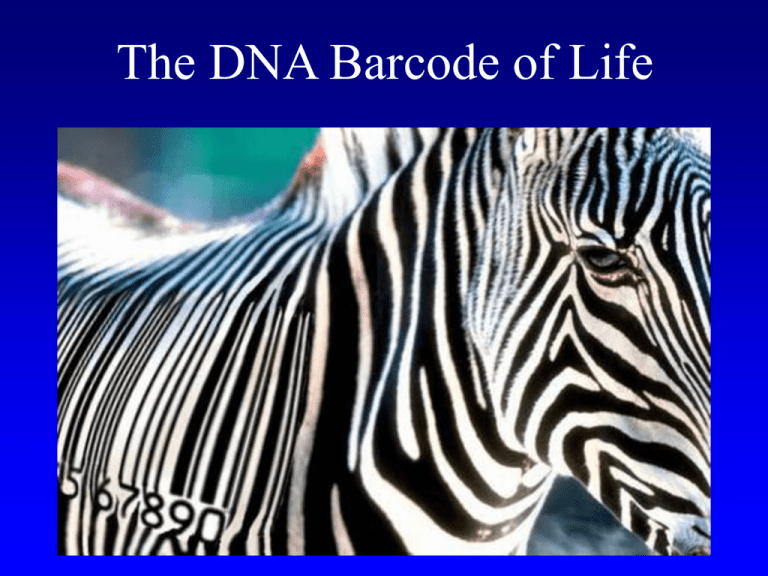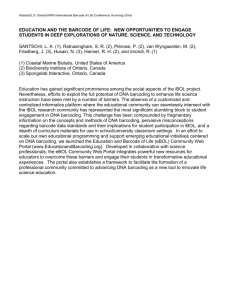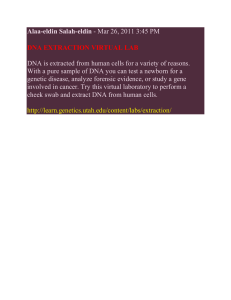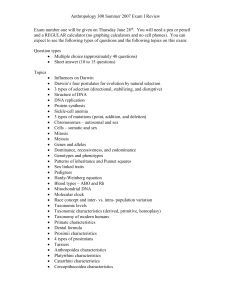DNA_Barcoding_Driskell.ppt
advertisement

The DNA Barcode of Life What is a DNA Barcode? • A fingerprint for identification • A short, easily and universally amplifiable, and reasonably variable piece of DNA • Current barcode markers: – Animals: 650 bp of the CO1 gene – Fungi: nuclear ITS – Plants: not decided What is the point? • Method of identification, particularly for nonexperts – – – – – Import/export and pest control Fisheries management Water and habitat quality assessment Partial or fragmentary sample analysis Associating different life stages • Biodiversity Exploration – Discovery of sibling species – Quick assessment of local genetic diversity – “DNA assisted alpha taxonomy” What constitutes a DNA Barcode? • Sequence is from a expertly-identified, vouchered specimen • Voucher meta-information required: GPS coordinates, photographs (in situ, in some cases), collector and identifier data • DNA sequence is high quality (minimum length, minimum coverage, minimum “quality scores” • Raw data (chromatograms) publicly available Where does the Data Go? BOLD http://barcoding.life.org Consortium for the Barcode of Life (CBoL) Univ. Guelph (Hebert’s Lab) Taiwan Australia ? SI Multi-institutional: DNA Working Group, Plant Working Group, Database Working Group, Analysis Working GroupAncient/Formalin Working Group Leading Labs: Protocols, equipment loans, laboratory space, training Current Products: BOLD, BioCorder Field Management Application, LIMS, TaxTube Collecting Methods Specimen Handling Suction sponges flatworms Electroshock Protocols Rubble Brushing jellies Malaise Trap worms Glass fiber Plankton Tows Beating Baited Traps TaxTube Sand Sieving organic DNA Extraction Primers & PCR Metadata & LIMS Permits ferns portable Kits QuickTime™ and a TIFF (LZW) decompressor are needed to see this picture. crabs snails tunicates Extraction Specimen fishes lizards Controversies Swirling Around DNA Barcoding - 2 causes • Cause 1: Thoughtless and ill-chosen words, arrogance, over-sell – “Will replace taxonomists” – “Species named based on levels of sequence divergence” – “Phylogenetic relationships discovered” – “Will uncover the meaning of life and everything” Controversies - Cause 2 • Potential for failure of identification, or mis-identification, etc. – Population and evolutionary history – Practical methodological issues Valid Concerns: 1. Evolutionary History • Hybridization (plastid genomes) • Pseudogenes • Heteroplasmy or multiple copies (nuclear markers) • Lineage sorting, recent speciation • Slow rates of sequence divergence Valid Concerns: 2. Practical considerations • • • • Lack of universality Co-amplification Incomplete sampling Lack of taxonomic experts DNA Barcoding at the Labs of Analytical Biology (L.A.B.) National Museum of Natural History My Barcoding Philosophy • • 1. 2. I’m not “discovering” species, not making trees Collaboration with taxonomic experts Train students, interns, other researchers Assist colleagues with lab setup, protocol development, etc. 3. Create a “lending library” of high quality, wellvouchered DNAs L.A.B. Projects: 1. Saving the world • • • • • Bird Strike Identification (w/ USAF, FAA) Economically Important Plants of the World (ofW) Tephritid fruit flies ofW Mosquitoes ofW; mosquitoes of Korea (w/ US Army) Stream monitoring through aquatic insect larvae (w/ EPA) • Just what is that fish fillet? (w/ USFW, USDA, FDA) • Wasp parasites of drosophilid fruit fles • Invasive Tunicates and Bryozoans (w/ SERC) Traditional Species Identification: Size, shape, color, feathers, etc. easy harder impossible? L.A.B. Projects: 2. Exploring Biodiversity • Association of larval and adult fish - Caribbean; spawning patterns and chronology • Frogs of Central America - pre and post chytrid fungal invasion • Plants of Panama • Tunicates of the Mediterranean and Red Sea • All Bocas Barcoding Alliance (ABBA) • Ophiurids of the Antarctic • Deep-sea isopods • Gastropods of Vanuatu • Biocode Moorea Identification of Larval Caribbean Fishes: Association of adult with larva Carrie Bow Cay, Belize Association of larval photographs and DNA “barcodes” with identified and barcoded adults EASY DIFFICULT Identification of Larval Caribbean Fishes: Association of adults with larva All Bocas Barcode Alliance (ABBA) Sponges July 2006 Octocorals July 2007 Tunicates August 2006 2008 •Algae (also 2007) •Shrimp Hydroids August 2006 Nudibranchs August 2006 •Nematodes * A South Pacific Coral Reef: BioCode Moorea * * * * Barcode of Life • Valuable Resource – Loss of taxonomic expertise – Need for identification, practical and exploratory – Rapid survey methods valuable • Requirements – – – – – Pitfalls acknowledged, explored, tested Collaboration Good curation Public availability Additional molecular markers a no-brainer.



